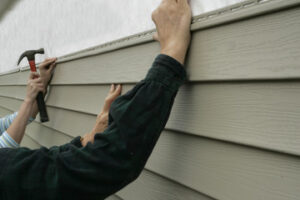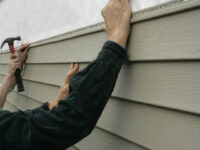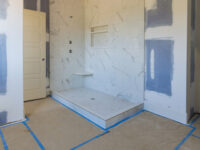Types of Siding
Siding adds beauty and value to a home while protecting it from harsh weather conditions, locking in heat or cold, and warding off pests. But there are many different types of siding, which can be daunting for a homeowner. Read on Top Notch Roofing/Siding for more information.
Fiber cement siding, also known as Hardie board or HardiePlank, is one of the most popular home siding types. It combines cement, wood fiber and other additives that make it more challenging than most traditional siding materials. While it can be more expensive upfront, its longevity and durability make it an excellent investment. It is also highly resistant to fire, moisture, insect damage, and rot. It is also impact-resistant and can withstand harsh weather conditions, including hail and high winds.
A number of companies manufacture fiber cement siding, but James Hardie Industries is the most well-known and popular manufacturer of the product. The company’s siding is available in a variety of textures and surface designs, and it comes pre-primed with a range of colors. It can also be painted if the homeowner wants to customize the color.
Unlike natural wood, which is harvested from trees, the wood used in fiber cement siding comes from recycled sources or reclaimed wood. It also has forest-saving properties, which reduces the amount of fresh wood that is needed to build homes. The reclaimed wood is blended with Portland cement and silica, which makes the material more durable than traditional vinyl or aluminum siding.
Its versatility means that homeowners can choose from a wide selection of styles, from the classic look of stucco to the look of wood clapboards or cedar shingles. It can even be made to resemble brick or stacked fieldstone, and it is available in different thicknesses. In addition, it can be molded into different shapes and sizes and can be installed in both vertical and horizontal configurations.
Because of its strength, durability and resistance to rot, mold and insects, fiber cement siding can last up to 50 years when properly maintained. Regular washing with a garden hose and the application of caulks and sealants can keep the material looking good.
Homeowners with a strong working knowledge of construction practices can install fiber cement siding themselves, but it’s typically best to hire a professional. This is because the product is heavier than other types of siding and requires special tools for cutting. Also, mistakes can have a significant impact on the performance capability of the siding, so precision and attention to detail are key.
Vinyl
Vinyl siding is a popular cladding option for homeowners looking to enhance the look of their homes without spending a lot of money. It is easy to maintain and can improve energy efficiency. The main component of vinyl siding is polyvinyl chloride (PVC), which has been combined with other chemicals to create a durable, weather-resistant material. The resulting mixture can be extruded into different shapes and sizes to create an array of unique styles.
When it comes to color, manufacturers use pigments and coloring agents to create a variety of shades and tones that mimic natural materials, such as wood or stone. In order to resist fading, UV stabilizers are often incorporated into the formulations of pigments and dyes used in vinyl siding.
Manufacturers can also incorporate textures into their vinyl cladding products. This allows them to achieve a more authentic look that is not only visually appealing, but can also feel like real wood. This gives homeowners a more custom option that they can use to make their home stand out in the neighborhood and give it a truly unique look.
Aside from being durable and low maintenance, vinyl siding can help save homeowners money in the long run because it does not require refinishing or regular painting. Additionally, vinyl siding is an energy-efficient material because it provides insulation for the walls of a house. This can help keep the interior of the home cooler in the summer and warmer in the winter.
Before you choose a color, take the time to review inspirational photos and homes in person to determine what looks best on your own property. It is also important to consider your neighborhood when making a decision because you may not want to be the only house on your street with vinyl.
Another thing to consider is the potential impact that vinyl siding might have on future homebuyers if you plan on selling your home in the future. Although it is inexpensive and offers many benefits, some homeowners believe that it degrades a home’s value and should only be used on newer homes or houses that are being rebuilt or restored to their original state.
Cedar
Cedar siding is a beautiful option that can give your home the rustic charm of log homes or the clean lines of a modern cottage. It is also a great choice for homeowners looking to increase the energy efficiency of their homes, as cedar has double the insulation of other types of wood sidings.
Cedar is a natural, renewable material with high durability and beauty. It resists moisture better than most other woods and has natural oils that repel pests, fungi, and other microbes. As a result, it lasts longer than other types of siding, including fiber cement and vinyl. However, it can be more expensive than other types of siding, and requires more frequent maintenance to keep it in good condition.
When properly cared for, cedar can be a long-lasting and affordable siding option. Its natural oil helps it resist moisture and rot, making it less likely to need re-painting than other types of wood. It also has a unique resistance to mold and mildew growth, which is a problem for some other types of wood.
A common type of cedar siding is bevel siding, which is milled to have one smooth side and one rough side. It can be left unfinished or stained for a natural, rustic look. It is often a more cost-effective choice than solid clapboards, since the bevel cut allows lumber to be used more efficiently by getting two beveled panels from one clapboard.
Other types of cedar siding include drop channel and tongue and groove. Tongue and grove siding has a small ledge on the grooved side that overlapping boards create. This allows the boards to expand and contract with temperature changes without buckling or separating. This style of siding is more commonly used on sheds and barns.
Drop channel siding has a similar design, but is typically wider and thicker than tongue and grove. It is also more cost-effective than bevel siding, but may be more susceptible to warping and shrinking.
Despite its attractiveness, cedar is a flammable material that can pose a fire risk if not properly treated with fire-retardant chemicals. In addition, it is not as rot-resistant as vinyl or fiber cement, so it may need to be replaced more frequently.
Steel
Steel siding is one of the most durable exterior materials available. It stands up to fire and pest activity, as well as the elements of nature including high temperatures and strong winds. It also resists moisture and fungus, as well as warping or shrinkage from extreme temperature changes.
It is available in a wide variety of colors and textures, making it easy for homeowners to find hues that amplify the aesthetics of their homes. It is also more affordable than other types of cladding. Steel siding is incredibly long-lasting, with a lifespan that exceeds 50 years.
Although it is highly resilient, there are some aspects of steel that can make it less desirable than other options for residential cladding. For example, it does not hold up very well to salty air. It can become rusted and may need to be replaced more frequently than other materials. It is important to be mindful of this risk when selecting steel for a coastal home.
Another drawback of steel is that it does not hold up as well in humid environments, as it can be susceptible to corrosion. In addition, it is not as heat-resistant as some other materials.
Today’s steel siding is manufactured with a combination of metal alloys, such as zinc and chromium. It can be galvanized or stainless steel. Stainless steel is more expensive, but it is up to three times stronger and withstands a lot more pressure than galvanized steel.
Unlike wood, steel does not rot or succumb to insect activity. It is also much lighter in weight, which makes it a more convenient choice for homeowners who are worried about damage from storms or high wind speeds.






